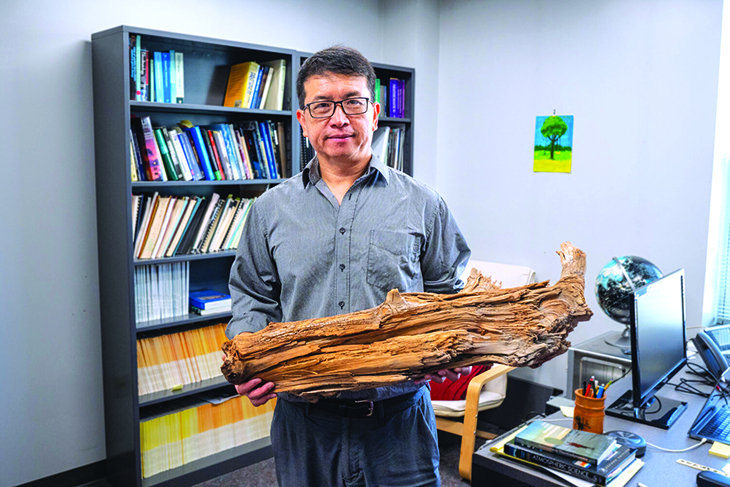‘Wood Vaulting’ may enhance CO2 sequestration

A recent study published in the journal Science reveals that a 3,775-year-old preserved log could significantly enhance strategies to combat climate change. The research highlights the log’s remarkable preservation, attributed to the low-permeability clay soil in which it was buried.
Conducted by a team led by Professor Ning Zeng from the University of Maryland’s Atmospheric and Oceanic Science department in the US, the analysis found that the log had retained over 95% of its carbon dioxide content, indicating that the conditions surrounding it were ideal for long-term preservation.
Understanding the environmental factors that contributed to the log’s longevity could play a crucial role in refining an emerging climate solution known as “wood vaulting”. This technique involves taking wood that is not commercially viable – such as trees damaged by disease, remnants of wildfires, or unused construction materials – and burying it to prevent decomposition.
This method aims to enhance carbon sequestration, as trees naturally absorb carbon dioxide throughout their lives. However, once they die and decay, that stored carbon is released back into the atmosphere, exacerbating global warming.
Key findings
Zeng noted the simplicity of the concept: “People tend to think, ‘Who doesn’t know how to dig a hole and bury some wood?’” However, he stressed the importance of appropriate conditions for preservation over long time scales. He referenced the numerous wooden coffins buried throughout history, many of which did not survive, underscoring the need for specific environmental factors to ensure longevity.
The discovery of the ancient log occurred during a wood vaulting pilot project in Quebec, Canada, in 2013. While digging a trench to bury fresh wood, Zeng and his team stumbled upon the well-preserved log approximately 6.5 feet underground.
“When the excavator pulled a log out of the ground and threw it over to us, the three ecologists I had invited immediately identified it as Eastern Red cedar,” Zeng recalled, expressing his amazement at the discovery.
While previous studies have examined preserved wood samples, they often neglected the surrounding soil conditions critical for long-term preservation. “There is a lot of geological and archaeological evidence of preserved wood from hundreds to millions of years ago, but the focus of those studies was not on engineering a wood vault to preserve that wood,” Zeng explained.
Primary factor
In 2021, Distinguished University Professor Liangbing Hu and Zeng conducted an in-depth analysis of the log’s microscopic structure, chemical composition, mechanical strength and density.
Their comparisons with freshly cut Eastern Red cedar logs indicated that the ancient sample had lost very little carbon dioxide, reinforcing its extraordinary preservation.
The clay soil’s low permeability was identified as the primary factor in the log’s condition. This type of soil limits oxygen access, inhibiting decomposition by fungi and insects, the usual decomposers found in soil. Given the widespread occurrence of clay soil, wood vaulting emerges as a viable and low-cost climate solution applicable in various regions.
Zeng emphasized that while this method could contribute to mitigating climate change, it should be implemented alongside other strategies to effectively address global warming, including reducing green-house gas emissions. As the team continues to optimize wood vaulting practices, Zeng is eager to apply their findings in real-world scenarios.
As researchers strive to develop innovative solutions to combat climate change, the study of this ancient log offers a promising avenue for enhancing carbon sequestration efforts and refining our approach to sustainability.
Comments

- ‘Red gazelle’ makes window installation easy
- Felder’s solutions for window and door production
- Versatile sliding-folding systems from Hafele
- Door line automation from Woodtech Consultants
- Accutec solutions for uPVC windows
- Jowat’s VOC-free primer for window profile wrapping
- Flexible solutions for doors, windows from SCM
- Tostem introduces Giesta steel doors; calls for dealers
- Folder system by Salice optimises cabinet space
- Turakhia has top-quality veneers for doors
- Mirka has solutions for difficult sanding of doors
- When Lamello’s Cabineo became a game changer
- Digital lacquer embossing for flooring from Hymmen
- Weber sanders help achieve luxury surfaces
- Rehau has designs on growing edge band market
- Samet ties up with Greenply to tap Indian hardware market
- IMA Schelling sets up base in India
- Hettich earns BIS nod for hinges, runners
- Biesse India now a Multi-Material Expert
- The importance of selecting the correct tools
- Indian cabinet maker shines at Lyon WorldSkills
- ‘Collaboration holds the key to success’
- Fibreboard recycling becomes a reality
- MumbaiWood now a recognised destination
- Knock on wood: A bouquet of training courses!
- Ligna 2025: ‘Thinking in circles’
- CIFF-Shanghai focuses on furniture design
- Felder hosts in-house show, Technology Days
- Interzum Forum Italy makes impressive debut
- Koelnmesse ties up for 3-in-1 Jakarta fair
- WOFX: a global hub for innovation and growth
- Events Calendar: industry fairs you must visit
- 3D is printing sustainable housing solutions
- Hard or soft? Researchers discover new wood type
- Master, apprentices take AHEC’s cherry challenge
- ‘Zero-to-launch’ modularity transforming hospitality
- ICA’s Urban Matter is about satin-finish metal effect
- MTC’s ‘Woven timbers’ create waves
- Impact of material in interior design
- Underestimated danger: Sharp edges
- Playing safe on clothing storage units
- ‘Green’, 3D-printed panel floors it!
- Adhesive-free joining of wood, metal
- Energy-efficient manufacturing of fibre-based products
- Rice bran wax: a sustainable alternative
- Dual-side hand sanding block has unique features
- Bio-based products for sustainable development
- ‘Wood Vaulting’ may enhance CO2 sequestration
- Protecting forests through advanced AI
- Forest certification benefits wildlife too!
- Elizure, the Rolls Royce of laminates!
- Rehau unveils new Rauvisio Riviera collection
- Hawa Concepta III: upgrade to seamless functional doors
- Hafele’s RE-Twist locks in on security
- Optimus machines feature tomorrow’s technology today
- Merino unveils cutting-edge offerings
- Ornare launches new premium laminates
- New nesting models from SCM
- Advanced moulder, membrane press from Woodtech
- Greenlam Laminates unveils exclusive display centre in Pune
- EUDR implementation dates may be deferred
- Herman Miller introduces bamboo upholstery
- Altendorf named ‘Brand of the Century’
- Catas to verify its test reports
- Combilift wins two prestigious awards
- Holz-Her management transition
- Replica of the Oval Office opens
- Ozone Blu sets up experience centre
- SCM opens new subsidiary in Slovenia
- VDMA faces business stagnation
- RentoMojo reports strong growth in FY24
- Century Plyboards on expansion mode
- Subhra named DG of FSC
- Meta to assist Skill India Mission
- Sugatsune opens Bengaluru experience centre
- Dieffenbacher acquires Pagnoni
- Pepperfry partners with Infra.Market
- Hafele opens light store in Chandigarh









































